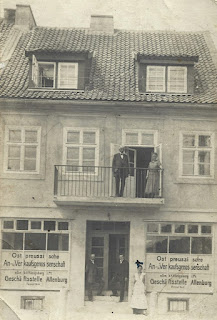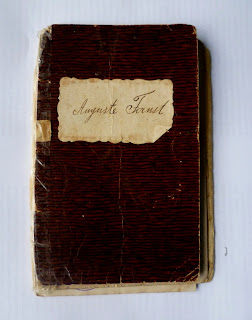Every picture tells a story No. 25
Auguste, daughter the East Prussian patchwork family, worked as a housemaid from the age of 14, until at age 24 she went westwards, travelling 1,000 km to Hamborn, and married a fellow East Prussian migrant there. She first started working at Friederikenruh, where her parents were also employed, then at age 19 went off to Wargienen, near Tapiau, later to Neumühl near Allenburg (NB: Neumühl is where her future husband's brother was photographed playing the fiddle, this may or may not be significant). The final employment documented in her workbook was also in Allenburg. All these places were in the Kreis Wehlau, to the east of Königsberg.
Here we see her posing outside a place in Allenburg where she also worked, but which isn't documented in her record, so we don't know the time for sure, must be around 1919.
The signs read: "Ostpreussische An- u. Verkaufsgenossenschaft eGmbH Königsberg i. Pr. Geschäftsstelle Allenburg, Fernruf Nr. 4." So this was the East Prussian cooperative for buying and selling things (not sure what, maybe agricultural machines?) registered as a limited company, based in Königsberg, with this branch office in Allenburg. Their phone number: 4. Apparently there weren't many phones around in Allenburg.
The house, identified by the balcony and the unusual division of the groundfloor windows, also appears in this postcard from the 1930s on the right hand side, suggesting that it is located on the town's market square. Oh, and in this one too, from 1930-33.
Note how the servant is outside the frame (of doors and windows) whereas the other people presumably including her employers, are in the frames. Also, she stands at the bottom of the stairs whereas everybody else is higher up in the photo. Know your place as they used to say.
The photographer should have known though that placing people in dark clothes in front of the dark openings and her in light clothes outside the lightly coloured wall would give poor contrast. Her face isn't very well resolved in the print either, so instead of zooming in I'll just throw in a portrait from about the same time (later marked as ~1920 by her son):
And here is the work book which documents the employments mentioned above:
This photo is also on flickr.
Every picture tells a story series so far:
- string quartet Wuppertal Elberfeld 1927
- greetings from Adamsweiler
- Gastwirthschaft Ferd. Weirich
- quartet times three
- Neumühl 1923
- Tangermünde railway station 1889
- a singing lesson
- bei Wilhelm Geppert
- a bakery at Lorsch 1900
- Consumgeschäft von Julius Düsselmann
- Hanna and Ruth
- a young chemist
- school's out at Reichenstein, 1886
- a patchwork family in East Prussia
- the case of the missing grandmother
- checkpoint Glaner Brücke 1929(ish)
- finding Mimi
- five sisters, five decades
- happy at home
- gone milking
- steel workers
- field work
- what to wear at Porta Westfalica
- a classic convertible
- at the bottom of the steps
Alternatively, you can use this twitter thread as an illustrated table of contents.
In a somewhat roundabout way, this series relates to my research for the family history music memoir I have now completed in a first version.



No comments:
Post a Comment